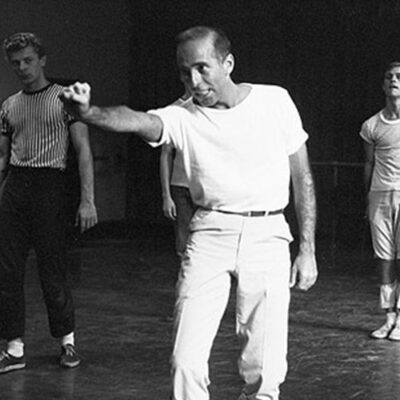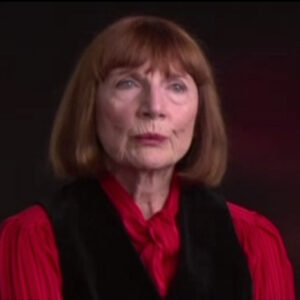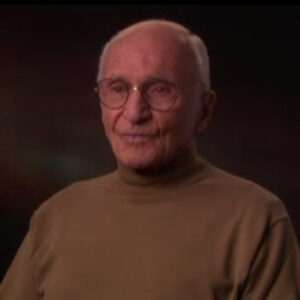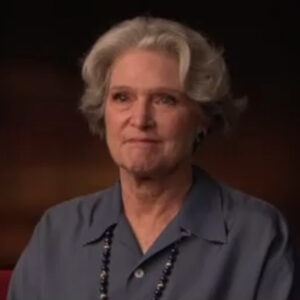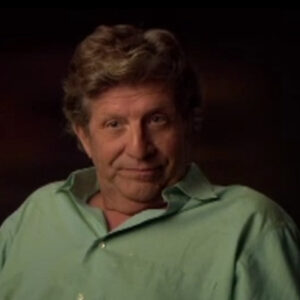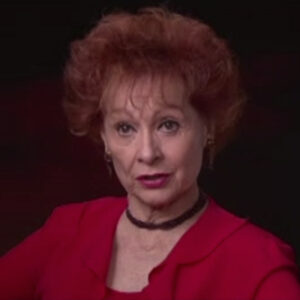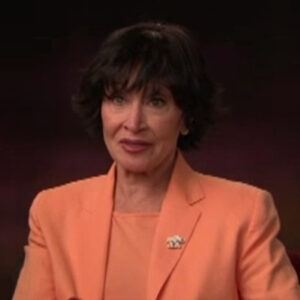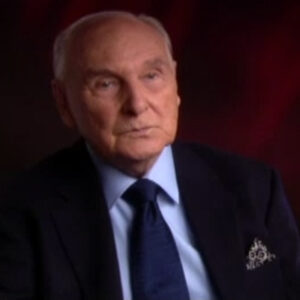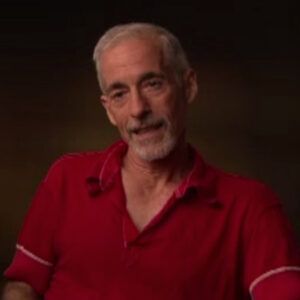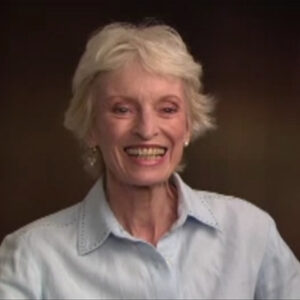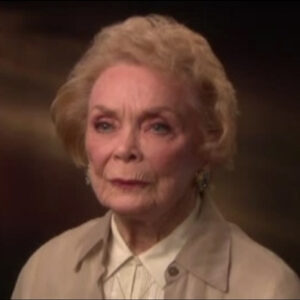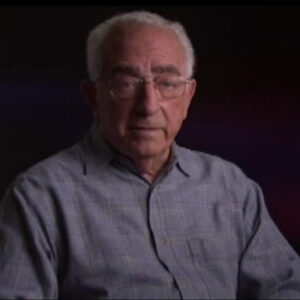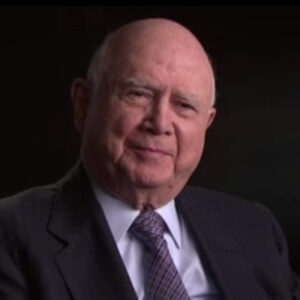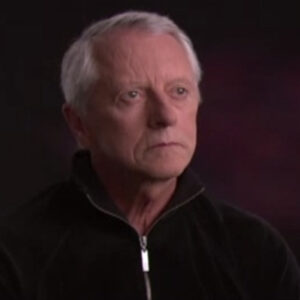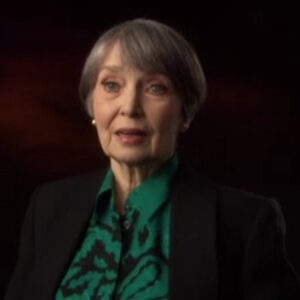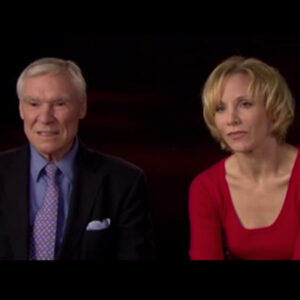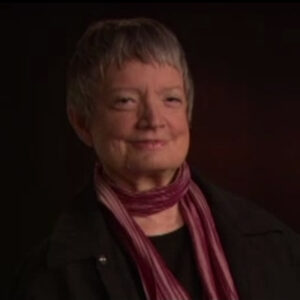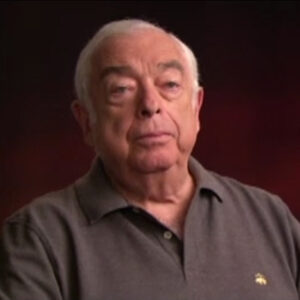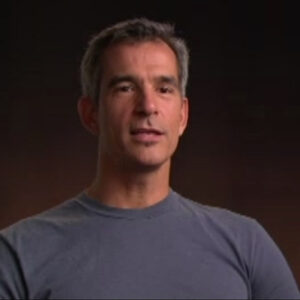Speaker Jerry was a wonderful dancer, just a superb dancer. He was while he was small, very wiry. He did his his solo for himself, of course, that the three solos, but he chose the one that would, of course, show him off the best advantage, although, of course, he did all three. I’d seen him do in court about stuff. Alecko, I remember very well he was in the Corps, but I have a photograph of him somewhere looking. Wonderful. And then he did a four Damu Agnes Middle in Three Virgins and the Devil. He did a crossover, it was the devil just walk. I don’t know if you’re familiar with walking across and brought the house down. Agnes, of course, had devised it and had announced that barnstead. But of course, she choreographed it. Agnes always said, well, I was the one who discovered Jerry Robbins because I had him do this cross over. And he was a terrific dancer. And of course, choreographers differ in the way they demonstrate how they want you to do. He did it for you. He did it specifically.
Speaker Now, tell me you were actually I’m going to wait, I’m going to ask you. Yes. I’m going to ask you, what were the circumstances of your first work with Jurema?
Speaker Well, I’d known a Jered just slightly that is socially.
Speaker I’d met him at parties. Then he was starting to work on Billion Dollar Baby. He’d seen me in while I was at that point currently in a show called Bloomer Girl, Agnes Daniels third show, I think. Yes, I think so. And he came backstage or wherever we met. And he said, would you? Audition for me for the show I’m doing yuppy. Of course I will. Jerry Jerry by then was Jerome Robbins. He had not become Girona, but it was a nice thing to be invited to do. Well. We spent a period of two weeks. In a theater, it was the I think it was the same theater where the show was mounted, but I can’t quite remember it was the Alvin or the show played and it was an empty stage. And we worked many, many hours and he constructed the piece that Joe MacCracken and I performed as he was auditioning me all of the steps, all of the lifts, everything. So at the end of the two weeks, he said, well, you know, I suppose you can do this, you know, of Robin’s thing. Yeah, well, maybe I guess it’ll work out all right. That’s how I thought I got the part. There was no agent involved. There was no discussion about anything. He just did it. And it was fun because he was Joan and I lifted him and we worked everything out. How did Agnes feel about that? She was not pleased. She may have. Can you just incorporate my question? Oh. Oh, Agnes. Well, I was working for Agnes. I was in a show and Jerry and in her terms was rating her shows and taking his pick of what he thought with the better dancers. And she was incensed. She was feeling then, of course, rivalry, and she had no reason to do that because that’s the way things are. You move on or you move to other places or whatever. If you’re free to leave a show, then you go to someplace you think is better. She was not pleased at all. Not at all. And and that rivalry, although they they remained, I think, friends. But it was all still there. Still there. But Agnes had made those feelings about any choreographer who was who was on her level.
Speaker She actually wrote him a letter about it. Oh, yes. Yeah, so tell me your impression of Jerry. What was your.
Speaker Well, he was certainly the funniest one of the funniest men I’d ever met charm the birds right off.
Speaker He.
Speaker Well, I think that just sums it up funny and very charming and and closed at the same time, it was an area you didn’t know what area, what door it was, but there were closed doors. That’s not unusual. That goes for, I think, almost anybody. But you’ve got so far. And if you wanted to go a little bit further, perhaps you didn’t get there, boom. I don’t think he kept to himself. He was always involved in work. I don’t think he was a loner by any means. But in a sense, he was I, I, I was very fond of Jerry and he was very, very good to me, did very kind things for me along the way. Once I was I was returning from California and I had no place to live, really since the early days, and he said, well, come and stay in the spare bedroom for a while. And I did. And it was couldn’t have been better. Had to leave finally. And he actually had heard of an apartment on First Avenue. So you can move in there. And I did well, things like that. He was very generous with me. Did you have a good friendship? Did you have a closer personal relationship? No, not really. I was. Well, everyone everybody was in love. That’s always been my contention. Everybody was in love with Jerry. I don’t know that went the other way. But there is such a thing as, you know, is falling in love with talent. And I think most people did that. It was the talent was so enormous and so. Available, I mean, you got to put your hands on it. It was so delicious and I think there is a sense of. Being attracted to that, that can turn into a sexual attraction.
Speaker But it didn’t with you? No, no, no, Tony, in the rehearsal studio, how would you distinguish him from other choreographers?
Speaker I didn’t work with many. I worked with Agnes a lot. With Jerry, several different. Occasion’s. Jerry was, as I described, funny, charming, go in the door. Key in the lock, that’s it, no more Jerry, no more nice guy, then it was work and he turned it to somebody else, turned into the inventor, the. Deeply curious man, deeply interested in what you were doing, every inch of you. Deeply interested in how you were really reacting to what he was giving you, what he was talking about or demonstrating how he was, how he was. What impression he was making on you that would produce work that he wanted. That was the I think, the whole basis of the laboratory theater, his search for a means to direct actors. That is. To speak to actors like he spoke to dances and to speak to dancers like he thought he should speak to actors, he wanted to meld them both, certainly could speak to dancers. Dancers had a rigid technique, not rigid, but a technique known actors have techniques and some of them don’t. Actors have to be talked to in different ways as far as producing a performance dancers approach. It’s such trite material I’m talking about. But he wanted to be able to put the two together and mostly he wanted to talk. He wanted to be able to work with actors. And he tried it several times during his career on Street. That is dramatic material.
Speaker I’m going to ask you a little bit later about some of the detail from the American theater.
Speaker But just getting back a little bit to Billion Dollar Baby, I understand he did some extensive research for the show. Were you involved or aware of any of that?
Speaker No, I am thinking about this interview. I wanted to I wanted to say that he obviously had an eye. He would absorb things and would be put in put back here, and it was like a computer and it stayed there, logged somewhere ready to whenever he wanted to use it, boom. He pushed that key and it went he obviously did a great deal of research on the movement. Then, of course, took it and went. Applied the theatricality and the the story elements, whether they were abstracted from that, but certainly the period and what that movement went to push the story along just visually, if nothing else, very acute about costuming. He may not have known a great deal at that time, but he was already pushing about his ideas and gathering his ideas. And I don’t know how he and Sharov got along, but I would think very well.
Speaker Tell me a little bit about the show itself. What was Billion Dollar Baby about it?
Speaker About gangsters in the 20s? Oh, yes, of course. Billion Dollar Baby was about gangsters that period 20s roughly, and about flappers and gold diggers and older gentlemen with the flappers on their arms. And that’s about that was what it was about the specific story. I don’t recall.
Speaker I don’t know what it was that was brave. Tell me about there was a big dance number later. It was reproduced. You know what I’m talking about.
Speaker I don’t remember any big dance number. Later, it was reproduced in Jerome Robbins Broadway. You know what I’m talking? Yes. Oh, the Charleston. You know, because I don’t remember. And I wasn’t in it. No, no.
Speaker But sometimes, you know, it’s curious. Sometimes people if they’re not in a no, they always remember better because they have a picture of. Yeah. Just what they did.
Speaker I don’t recall it. I do remember. I remember entrances things in one, the crossover things, but what they were they were essential to shows them because they didn’t have that magic going on. So to change the sets and back, they had to do the crossover. And they were it was kind of a test or a measure of your creativity to make that that happening in one and do it quickly. And you know what I mean. Tell you about George Allen, who was and how did Jerry relate to each other? I know nothing about George, but except that he directed that in his career. I really I really don’t know. I suspect that they got along very well, but I really don’t know.
Speaker I never saw them working together. I don’t know. I can’t answer that one.
Speaker OK, you know, it’s hard it’s hard for me to know until I ask you what you were privy to in particular.
Speaker Yeah. And you’ll find that. I don’t know. I don’t remember. I just don’t remember.
Speaker You wrote or you said I mean, I read that you you said this that you didn’t believe that. Wait a second. Yeah. You didn’t believe that Jerry was bisexual, although he had affairs with both men and women.
Speaker And I’m wondering if you could explain whether Jerry’s with as to Jerry’s sexual sexuality. I really I. I would say Jerry was homosexual.
Speaker I think, Jerry.
Speaker Might be called bisexual, he’s as far as I know, he’s I wasn’t there. He slept with women. So however you want a term that Jerry was always the experimenter, always the observer, I think he would have gone to bed with, you know, whatever to find out what was what that would be like, how he could use it. He used everything.
Speaker Everything you said he was a high strung man made it clear. What were you referring to?
Speaker I don’t recall. I don’t even know. He was conflicted. Jerry was complex and conflicted. We have to remember that even in the short discussion about his sexuality, perhaps he was conflicted there. I think maybe he was later on when he ran up against the UAE. Meetings, that was certainly a big conflict, he knew exactly what was at stake. Where what his standing would be in the community. That’s a big confliction.
Speaker Hmmm, I think that explains that as much as I can do, um, maybe ballet and Broadway.
Speaker Do you think that was enough?
Speaker I don’t think so. I think she knew exactly what he was doing. He he he used Broadway. What more could he do, I think in the back of his head, there was always the ballet and when he could, he just dropped Broadway, he signed off with. His tribute to himself, Robins on Broadway, whatever, whatever he called the. That was another record. I don’t think it was a conflict, I think he’d finished he’d done with that and he wanted to get back to. To the ballet, but after the long experience of Broadway and after the two years of the laboratory theater, I think he knew what direction to go. And that might have been one of the the the laboratory theater might have been one of the tracks to that because he dropped he went directly, as I recall. He may I don’t think he did another show after that. I, I don’t recall. He didn’t just.
Speaker Yeah. Would you say he was more of a realist or a perfectionist? And how did that affect the people around him?
Speaker Well, he certainly was a perfectionist. A real estate in his work or the work he produced or he was a real estate, I think he was a real estate. He certainly was a perfectionist. Oh, it’s it’s hard. He once said to me, I had been doing a little directing, you know, in the sticks. And I talked to him one time about that and the experience of directing and his experience of directing actors and those handful of things he did. He said it’s like you have a vial or a glass of water, pure clear water you see through. That’s your concept. And the actor you’re working with or even a dancer, for that matter, comes along. And there is this other personality than yours, another head, another way of thinking and boom, just a drop. And it colors that water so you can never get back to your purity. You have to go along with that. You have to there’s no way around it. It’s easier to do with dancers because a choreographer will pick a dancer that will closely interpret what he has in his head. So that’s that’s easier. That also goes for actors and directors.
Speaker But he could get to the purity. Easier with a dancer. That’s why he was so interested in actors and the the seeds of that whole experiment.
Speaker I think I think, um, tell me about how he was, if you can remember, in doing our baby, how was he in the rehearsal studio with the dancers?
Speaker Well, as I said before, tick a lock the door, the door closed and then he did laugh a lot. He he he would make jokes that his dancing jokes and he would laugh at himself or what he’d done or he would laugh at how the dancers did what he asked after the when the dancer took the movement and made it, as they say, their own, then he would laugh if it worked, if it worked. But he crafted it as any choreographer does, crafted it until it did work for him. Craft everything like a sculpture. Like a sculptor and the one of the important thing is, of course, about that is the keeping that that alive. So it looks like the first time you’ve done it, which is one of the tenants of of an actor’s performance and maintaining a certain level that it is the first time you’re doing it. So it doesn’t get shaded and corrupt.
Speaker How did the company feel about him?
Speaker He was not liked. He was not liked by well, he could he was he could be mean to. Dancers are.
Speaker In various ways, he could bring dancers to tears, dancers to leaving shows.
Speaker But not not many people actually left. I remember NOROC at one time, specific time she was.
Speaker Livid with him, and I’ll never work with him again, I don’t want to see him. Well, that that kind of thing. This was this was an occasion that I was with a ballet theatre. We were touring and we were doing an old ballet of Jerry’s called Facsimile, a three person. Originally it was Jerry. Johnny Cretz, Nora, so Jerry asked me to do his role. We didn’t have much time to rehearse before we left on tour, and we were performing it only in Paris. I think so we came to Paris and rehearsed this. The other two, Jerry. Nora or Johnny couldn’t teach me because they didn’t know they knew where I was, but they so I didn’t get much, much help from them, they were not too sure of what they were doing. Anyway, we got it on. And the the first time we did it, it was the show.
Speaker And Jerry Jerry walked up to me.
Speaker The curtain was down just before intermission. We were three of us were on stage warming up. And he came over to me and he said, Do a pirouette. I said, do to OK, I did too. He said not do three well, three pirouettes. I was not you know, that on a clear day I can maybe pull them off clean, clean ones. But I did. And he said, that’s what I want. Your hair. Yeah, that doesn’t endear you to a choreographer, nothing like good luck to break a leg or any of that nonsense. He then drew up a stool and just inside the stage, right. Proscenium arch, he sat. So he could see us, of course, and we could see him, that’s unnerving. And I think that that’s the point Nora snapped, that was about all she can stand, she was coming to the end of her, not the end, but of that incredible career she had.
Speaker What kind of a dancer was normal? Oh.
Speaker Fantastic. But, you know, Nora was well at my limited experience dancing with ballerinas. It certainly wasn’t. I only did Fall River Legend with her and one try at. The tooter. I can’t remember. Well, there it goes, it’s there, but I can’t remember, you know, she was a powerhouse, narika it was a powerhouse. That’s where she that’s where she lived, those kind of roles. Pillar of Fire Cage, the classical rules.
Speaker We’re not not really for her.
Speaker She was very generous on the stage where we got along very well, we didn’t have a very close relationship, but it was close enough. We always sat together on aeroplanes. She clutching me and I clutched her, scared everybody. That’s for the birds fly. We don’t spend, supposed to fly. And we joked around and we had we had a very good time on the stage. It was an experience I can’t recall anybody I’ve danced with some pretty snappy people, I suppose Jamshid OLAP was see the other one who was.
Speaker Oh.
Speaker Generous is the word I don’t know how else to explain that there’s a feeling that they that they give to you, they they yield.
Speaker They yield a portion of the stage to you, your portion.
Speaker That’s not very well put, but that’s about it. I understand. Tell me about facsimile.
Speaker Oh, well, facsimile. He said, well, now you enter stage left and you have this towel and you rub it back and forth your crotch this way, said Jerry. Surely not. Yes, that’s what you do, Jerry. That’s I don’t have to do it. So I did this in the 60s. And Ballay, you know, there was a lot of very tight stuff between the three of us that had to do with arms and legs curling around, messy, mixed in like a can of worms. But it was all to the beat and it was all choreographed. It wasn’t free stuff. Improvised was extremely difficult. Hard to remember. Nora hated the famous moment, the end. Toward the end of the ballet, she had to scream the word stop, meaning stop this madness we’re going through. Well, Nora had a very distinct accent, so it came out. I can’t quite do it. And I don’t mean to denigrate her in any sense at all, but it could get a little giggle out of you. And then on top of that, she said it’s almost over. She said to us, Nora mother during this muttered Quite often I I while I danced with her in Fall River Legen, this is getting off the facsimile of legen. Now, what was the other former village before you get off facsimiles?
Speaker What I want to ask you, if you can tell me what was the idea of this piece?
Speaker Oh, three people. Meeting on a beach, I suppose, propositioning each other, making out the who’s going to be on top, who’s going to go off with whom, the conflict, heavy conflict between three strangers, or if you want to put two people say Jerry Jerry’s or Johnny’s character, Nori’s as a couple, a stranger comes in or the three of them are strangers, all strangers however you want to. I think it would work in any kind of combination, but.
Speaker The explosion when three. Personalities. Can happen. That’s about it. That’s about it.
Speaker Now we get into facsimile, but we skipped over something that I don’t want to forget to ask you about. Billion Dollar Baby famous story. I know you know it. It’s come up a million times related to different shows. But I think the truth of it is it happened on Billion Dollar Baby. You know, there’s at least one Robbins’ biographer who has written that this is not true. Yes. So I want you to tell me, if you would, what you personally saw.
Speaker Well, I think it happened and Billion Dollar Baby. But I checked just yesterday with a dancer who was in Billion Dollar Baby, said Forest. Was it didn’t to be said? No, it was in another show.
Speaker He didn’t say what show it was, a forest, Bunshiro beyond his HAARP. He was a very famous gypsy, a gypsy. We’ll ask you how to find him, but oh, um, but oh, he’s wonderful to talk to happened. Yes.
Speaker So tell me what happened.
Speaker Let’s forget about which I was Jerry was addressing another of Jerry shows.
Speaker No. And you were there when it happened? Yeah.
Speaker OK, so tell me what he was addressing the the dancers as a whole. I’ve forgotten what it was about, but he was talking and as he was talking, he was taking a step side note to the back side of the back, who’s edging backwards to the lip of the proscenium of the.
Speaker That party apron, thank you.
Speaker And OK, sorry, Jake. All right, let’s just go back.
Speaker He was talking to starting to come in and edging as he talks. Oh, start again. Yes, there’s a famous story of Jerry that people attribute to different shows. Oh, it happened in the know. Didn’t that happen in that show? I saw it as well. I claim I saw it. It’s now become such a myth. Jerry was addressing the company, I suppose, just the dancers. So there might have been 12, 15 people on the stage. And he was talking, talking, forgotten what he was saying and stepping backwards and sideways and backwards and backwards. And he got very close to the lip of the apron into and he took another step and he fell backwards into the pit. It was pretty shallow and and the percussion instruments were on that side, which are never broken down. So they were probably with canvas. So anyway, he fell into that. No one no one went to his aid.
Speaker Just stood there and through their minds. Well, he got it.
Speaker Nobody came nobody came to his assistance at all. That’s how well he was liked.
Speaker Now everybody claims know it happened and I saw it in another show, so it’s become part of me.
Speaker If you were only a million dollar baby and you saw it, of course. Absolutely. That’s so forget about fast. I’ll take your word for it. Oh, you’re talking for us anyway.
Speaker I’ve heard many times dancers talk about Jerry making various versions of things and I wonder if you have any recollection of that was the decisive and decisive. Does that ring a bell with you?
Speaker No, no, no, no. He was secure or insecure. Can you give me an example? Oh.
Speaker But he would see the.
Speaker The solid US work I did with him over a long period was the was the experimental theater. Pardon me, I could see him working on something. He would leave. Disturbed he would come back in the next day and start working on that particular segment again. He he went into this, I understand, into the experimental theater with no obligation to produce anything. He didn’t have to put it on a stage. He didn’t have to show it to anybody. And I think only maybe three people either watched a rehearsal or not a rehearsal, but a session. And he did produce one piece, but it was in the House. It was never, never, not even a part of it was put on public view. That was seen by Bernstein. Mary. Director, big friend of Jerry’s name’s gone Mary. That’s right, Mary Hunter, and I think Robert Wilson might have seen it, maybe one or. To other people, but I can’t, but no, no one saw it, it was a fascinating piece and I’m sure somebody told you about that already. So, you know, you know all about they’re going to talk a little bit more about it.
Speaker But can you tell me what it was called, a full name and who paid for it?
Speaker Oh, I mean, of this piece of the whole experiment.
Speaker Oh, the laboratory theater, it was the American lab, American Theater Laboratory and theater laboratory.
Speaker You remember who was paid for by vaguely the government, the, I suppose, National Endowment. Yes, I know that. Yes, he was dreamy.
Speaker Well, I don’t know if you want to talk about that thing yet. Absolutely.
Speaker Well, he was very, very cautious. There wasn’t he had a camera going all the time and a secretary writing there wasn’t, Jerry. I have to go to the bathroom now. I can’t wait for the five minute break. I have to leave. It was recorded that time. How long they were gone, recorded and photographed and out of the room and back into the room when he wasn’t about to be accused of wasting any of the government’s money or the this contribution from me for the Endowment for the Arts. Scrupulous.
Speaker Now, this was after York, so I think he was being particularly careful so he could not be accused of wasting it. It goes with him anyway that he would record.
Speaker Everything just for just for himself, but that was one of the peculiar things in the 60s, Jerry embarked on a project that he called the American Theater Laboratory, and he applied, I assume he applied to the Endowment for the Arts for funding for this.
Speaker And it probably wasn’t difficult for him to get funds. He was, after all, Jerome Robbins, different people. People have different ideas about what he was about. To put it simply, I think he was it was about Jerry. Experimenting for himself, how to direct actors and the difference between directing actors and dancers, how their techniques would meld, how we could put them together to for his advantage in directing and choreographing.
Speaker He wanted to direct. He wanted to.
Speaker He wanted direct actors. I think that was his main theme, other people have other ideas about that.
Speaker What sorts of projects did you do? Well.
Speaker Let’s see, first of all, it was a learning, a learning experience for everyone, we had speech teachers and voice speech teachers, we had dance classes. I and a Sokoloff was the teacher. She gave a class in the morning, half hour to an hour, and it was more than just limbering up. It was some technique. And I had to leave and I took over those classes. I gave them my kind of modified ballet ballet class, tried to explain why I was doing that for them.
Speaker So.
Speaker It was a learning process for me. I think we were 14, 12, 14 1/2 dancers, half actors, the dancers had some experience in enacting the. The actors had practically no experience in dancing. He had one big project. That he kept working on over and over and over again in different variations.
Speaker That was the the assassination of Kennedy. He. Invented improvisations.
Speaker They were very complex. I couldn’t see where he was going with them, but he could see or he couldn’t see, but he was trying to see, he was trying to find a truth about them, about the event. Did this really happen? Was there a. A library who was with him, the assassination or the rifle, but everything about it, the the the amateur tapes taken from the the hillside. If I told you the nature of the improvisations, you probably wouldn’t believe or you would wonder exactly why he was going after that particular moment and we didn’t know either he would we would simply do it. We would construct in our minds a hotel lobby. We would play characters that perhaps were there or weren’t there, and we would improvise meetings. Sometimes with words, sometimes not just just very realistic behavior. I know this is not making any sense at all and it made no sense to us, but it did to Jerry.
Speaker He searched and he looked and he searched and looked.
Speaker And he would become terribly frustrated. I’m not getting what I’m not getting the information that I want, not not having anything to do with us, and we weren’t letting him down, he simply wasn’t it was not jarring him out of something at which time he would then fall back on doing a piece of choreography back to where he lived, what he what he did. And those were wonderful moments, just wonderful. He would just pick a subject and go to work on it. We did one. I remember particularly Hamlet meeting the ghost of father. We all had polls, that is a dowl Dowling’s you wouldn’t like hang curtains on and we manouver those in his direction. You can do this, you do that. And it was choreography. Abstract. But he made a peace, he made a peace.
Speaker Jerry.
Speaker Oh, it’s difficult to remember. Let me ask you something. It’s so difficult to remember. Yeah, go ahead. Did you have something else? No. So I understand that there was work there that was heavily influenced by Japanese. No. Of that.
Speaker Well, that’s the piece he did. He did produce one one piece that is I’m talking about at the beginning and at an end. And that had to do with the. With the funeral that was part of it with the committees that. And the hearings, the various people who testified on.
Speaker I could tell you how it was formed.
Speaker It it’s so abstract, it’s difficult.
Speaker But anyway, he had a V shaped space, I’m now talking, yes, a V shaped and it’s its point was upstage and then flying out from that point on one side, stage left were the interrogator interrogators and the other side were. Or in the middle were people who were testifying. He wanted he wanted to achieve a sense of concentration from this other from this other side as opposed to. The vagueness of speech. And not knowing these people who were interrogating, not being quite together, reaching out, looking for clues. As opposed to the other side? Absolutely sure of itself.
Speaker Rocks like granite, well, he achieved this.
Speaker By studying a particular Japanese right, which is the tea ceremony, tea ceremony has many different levels, you can do a little tea ceremony. You got a very elaborate tea ceremony. He had people from United Nations come in and teach us the tea ceremony. With the actual dishes, the powdered tea, the brushes, the water, the napkins, everything.
Speaker We learned it, all of us learned it, we learned to do it in unison, that is maybe six of us in unison. It wasn’t to a beat like one to it was just we knew it was very difficult, very difficult. He then took the props away, the dishes, and we simply. Pantomimed it in unison, in unison, very difficult because you couldn’t see anybody. But he achieved that, we achieved it, but he achieved it. He then took the pantomime away and we sat in the Japanese style news and thought. The tea ceremony. Well, I didn’t see it, but what he achieved was a concentration of atomic proportions. What he did with it, I will never know. I will never know he was interested in that kind of thing. He was interested in experimental theater he loved but don’t name names are not coming up. The culmination of this was testimony by Jackie Kennedy. And a man did this particular. Peace.
Speaker He held a piece of dowling. Which represented flowers. A piece of black cloth which represented the veil, the black veil and.
Speaker He improvised, he improvised a dance, I can’t tell you any I can’t be more specific about it, I just cannot. It was breathtaking and very chilling, very chilling. Downstage in front of everything was a party hat with a striped, so, you know, Uncle Sam.
Speaker Party at. That’s all it was, that was the symbol. Lord knows what Gerri was looking for, but it was fascinating to do fascinating will the end of all of this, what did the National Endowment for the Arts expect for their money?
Speaker Nothing.
Speaker Can you make up the he for this experiment, this two year experiment? He made the wrote up the grants and they the Endowment for the Arts gave him a goodly some perhaps in the 60s, as I recall, it was something like 300000 dollars, which doesn’t sound like very much. Now, that’s a phone bill. And as I said earlier, he or he recorded everything so they could be one of the stipulations was that he they would not see anything. They would never come in to look at his work. They they didn’t expect a piece that would be produced for the public, it would be what Jerry wanted to do and then it would just dissolve and go, except for whatever records Jerry kept. And I have no idea what he kept.
Speaker They didn’t he? I think he stopped before the allotted time. If I recall, that’s it.
Speaker The end of the very last day, I think it was, we were then moved to and kind of forgotten where it was, but we had two rooms, one large room we worked on, and there was another little room. And Robert Wilson was invited to this last day. And we were I think we were asked to wear leotards. Or maybe not even that may be just something that you could throw away. Not our street clothes, because there were many cans of paint and wide brushes and and ladders. Our instructions were to paint the entire room, the ceiling, the walls, the pipes, the doors, the floor. Everything had to be covered in paint, I’ve forgotten if they were colored paints or if it was all the same thing I recall, I think it was all black. Everybody had black paint or maybe it was red, but it was to turn this room of many objects of doorframes, window frames, pipes, thing, whatever, floor ceiling, turn it all in the black. Short of painting Jerry himself or or the other, even the ladders were painted, there wasn’t anything that was the end of that was the last thing he did, which was kind of a fall over into Wilson’s.
Speaker Kind of work, I think, but that was it, that was the end of it.
Speaker What do you think that the fact that the National Endowment gave Jerry that with no ability to see what he was doing and no guarantee of any kind of result, what do you think that said about Jerry at that time?
Speaker Hot stuff. He could do anything he wanted to do. Oh. The endowment at that time was pretty powerful, it dwindled steadily, as we all know. Well, obviously, he was considered in the high ranking serious artists in the country or may perhaps in the world, I would say probably worldwide. His influence, and I reckon they just decided that this was a man worth. Promoting giving money to see what he see what later would would, but he would produce from what the results would be and they were interesting.
Speaker How did the performers feel about having all of these exercises and discussion, but no performances?
Speaker I didn’t mind. I don’t think anyone else thought it was we understood what was what was happening. He he asked me. He called me to his office, which was not in his house. He didn’t have but set up audience office and said, Jimmy, we’re going to do the I’m going to do this. And would you be interested in working for this project? And I said, yep. So that’s it, you’re in. Next thing I knew, I had a call to come and audition.
Speaker Sing, dance and act.
Speaker I didn’t say, Jerry, you know, you’ve seen me seeing receive me that you seen me act, you’ve seen the whole thing. I’ve auditioned for you a lot. No. Well, I suspect that there was just. As a precaution, he had to do that, he had to part of the contract, perhaps.
Speaker But it was strange everybody had to do that on.
Speaker I think the first ballet he produced after this was, well, there goes the name, it was a solo or wasn’t together, you know, for for Edward Lalala Watermill Watermill. Yeah. Can you go back and start again? Yes. When when Jerry had finished with his. Experimental theater, he went back into producing or choreographing for the Balanchine company. And I think the first piece he did was called Watermill, and as I recall, it was. Totally a solo for Edward Villella, and it had in it. Traces of what we had done throughout the whole two years of the experimental theater, there wasn’t anything specific, but all of us who had worked with him could feel. That he had used the experience in this ballet. He made his mind set about choreography and what he wanted to do was. As far as we can serve, totally different, totally, totally different, a depth to it.
Speaker I don’t want to use the word seriousness, but. The depth, a whole different dimension of how he was thinking.
Speaker Do you relate it, could you relate for us this whole experimental activity to what was going on at the time in the 60s?
Speaker No, I couldn’t I wouldn’t be able to do that. No, no, um.
Speaker You actually spoke at one time, I think if I’m getting this right, about the effect of Jerry’s work in the lab on his ballet dancers at a gathering.
Speaker Any recollection of that?
Speaker I don’t recall that I ever said anything connecting to dancers and gathering and the experimental theater. I don’t recall, except that it might have been. I don’t recall.
Speaker Do you think that might have been thinking of Watermill actually at the time? Because I thought it was odd myself when I read it. And now when you talked about it, you mentioned Watermill, which is a much more obvious connection. Yes. I’m just going to ask you to begin the Watermill section again, because, in fact, it was not a so I.
Speaker Yes.
Speaker So you remember, because that was the strongest visual. Yes. But if you could just start that part again.
Speaker When Jerry had finished his experimental theater, his investigation, actors, dancers and how they can be. But his first ballet after that, to the best of my memory, was a piece called Watermelon and all of us that people who had worked with him in the theater, who saw in all of us, agreed that it was a direct.
Speaker Not particular quotes from what things that we had done, but in feeling.
Speaker In what he was looking for, besides just movement, it was a oh, it’s so hard to explain, it’s so difficult to explain. Don’t torture yourself. I just it’s very difficult for me anyway.
Speaker It’s not you. And it’s really as much of an experiment in time as anything else. So don’t worry about it.
Speaker I just can’t know about and I haven’t seen it for 100 years anyway. Well, you don’t want it.
Speaker Do you think that the notion that Jerry didn’t have to produce anything at the end of the lab was a good thing or a bad thing?
Speaker And could you explain why, Jerry, at the end of the day, he’d made an agreement with the Arts Council that he didn’t have to produce anything. There was nothing to be shown. I think that freed him to.
Speaker Not meet a deadline not to satisfy our producer or a director or constraints as far as money was concerned, he if he had wanted to continue, I’m sure he could have gotten more money from the government. I think he was. It just allowed him he’d he’d purchased a free time where there was no constraints, nothing, it was just Jerry working and of course, that answers all of us considered a privilege to be there and experience not to be had anywhere else. I think probably in Europe, Grotowski and those experimental people, Bausch and all that kind of thing, all those all those people, they were their money source was a little more lenient. A German.
Speaker Here it was much more constricted, so. I don’t think any of us wanted to show any work. I don’t think he wanted to show I know he didn’t because he didn’t he asked to leave. He didn’t have to show anything, nothing.
Speaker I think you you helped a little bit, did you, on Jerome Robbins Broadway?
Speaker No, Jerome Robbins Broadway, a compilation of his his work, what he wanted to make.
Speaker Who knows why Jerry did it?
Speaker But he was doing a sections from different shows, and one show that I’d been in called Billion Dollar Baby, things that he wanted to use. So he reconstructed these pieces of. Yes. These pieces. And he asked me to come to the studio and look at it and see if I thought it was accurate. So it did and it looked accurate to me. I Jerry, I think you ought to take up choreography because it’s very, very good. He didn’t laugh. He didn’t use any of the stuff in the show. Finally, I said, Jerry, the power to do that, I did with Joan, parts of it. There was a spectacular lift at the end and I can’t remember how it was done. But it ended up Joan was upside down. I was upside down. And he said, oh, I remember not take a hole in my my ankle and I’ll take over the shoulder. And I said, lift. And I work. And he was upside down. He was small enough that I could do it like that. He remembered nothing. Everything was, as I said earlier, registered in here. And he was able to recall all of that without any help.
Speaker How have you changed over the years?
Speaker Well, over the years I didn’t see him. The last last time I saw him was the state theater. And he was down sitting down close and he didn’t look well and he was moving slowly and he was he was ill. Another time later. Later on, I happened to be sitting next to him. There was Jerry. Hello. How are you? And would you like to come up and see my office? I happened to be with a friend who was a dancer, and I said, I’m with a friend. I went and he said, bring a friend. So we went backstage and we just looked around. His office was interesting. He some somehow wanted to show me I don’t know why, what he was being very friendly. He won’t let me in a little bit, don’t know what that was, but then you never knew what Jerry was thinking after turning Point a movie about vaguely I was playing a character was a combination of Geryon and Tooter. I think I saw Jerry on the street and the first thing he said to me is, give me back my beard. I’d also been asked by the director, shaved my head, Allatoona. I didn’t think I would do that. But then. I didn’t. Well, yes, I did lose track, we just did not meet that he was moving in circles then that that I, I don’t know if if if dancers still had a place in his life like the old dancers. I really don’t know. What did you learn? Mostly I learned about improvisations from Jerry. His contribution to me as a dancer, a performer, was the nature of improvising, improvising. It always meant to me being able to suddenly do a scene that is you’re given a character and another somebody and you are to an act. On the moment.
Speaker An event.
Speaker This meant being able to invent lines and make a play off the top of your head. People can do that. It’s not I I learned another kind of improvisation from him, that you could do anything that whatever came into your head with this, you have the plot. You want to do movement. You could do separate words. You could approach an improvisation in any way you wanted to and.
Speaker With thought behind it that I’m not just saying we you know, I jump into it, but the thought behind combination movement and words, you can accomplish an improvisation of what you’d been asked to do it, not be specific, literal.
Speaker It is a product. That freed me up a great deal for performing.
Speaker Anything, of course, it has to be on the nose specific because a lot of people are depending on you to be on the nose specific, but it gave me a certain kind of freedom. That kind of thinking. Oh, and besides, Jerry contributed to my happiness on many occasions, he was generous, he was joyful.
Speaker He was me, I mean, as a snake, but he’s he was he’s been a major part of my life.
Speaker Major, where would you place him? Sort of musical theater pantheon of talents?
Speaker Well, of course, on the top. But then we have Fozzie, Fozzie and oh, you ask me where I where I rank Jerry in. Entitlement and importance in the musical theater and certainly one of the certainly one of the greats, but we’re also talking about falsey and oh, memory’s gone. Memory’s gone. Oh, help me. Help me. Who are you thinking? Well, I wish I could know if I can think of about the person. Oh. No, not Gowa, no, well, Gowa, Michael Bennett, of course, Michael Bennett, yes, of course.
Speaker Yes, they were up there.
Speaker Oh, always especially see what happened in the are as far as preeminence in in the theater. We have Agnes Cherry, but what those besides Agnes, they went after the directing positions, then they had full control. They didn’t have a producer or a director say, well, you can’t have that ballet here because it’s too long to the turnover. They had the whole thing in their hands. And that’s that’s what those upstarts after Agnes did that she was unable to do.
Speaker Is there anything about Jerry that you would like to tell me that I haven’t asked?
Speaker No, I don’t think so, I just said how I how I remembered who Jerry. He did he was an influence on me, he was a part of my life, even though the last 10 years I didn’t see Jerry, I saw his ballets, but I never saw him.
Speaker And I wanted to, but not enough to ever write to him or find no, I knew where he was living, but not enough to intrude.
Speaker In his life, Jerry was respected me. I know he did. And I respected him enough. Not to intrude on him, or perhaps I thought maybe I would get a negative response. I don’t know. I don’t know. But I did miss him and. I was. Taken aback at his death.
Speaker That talent. Shocking.
Speaker Shocking. Inevitable. Anybody know anybody?
Speaker He once gave me a wonderful present. It was in California during the filming of or whatever he contributed to West Side Story, and he said to me one day out there, would you I have to go to Stravinsky’s house for a conference? Would you like to go along? Sure. So we went and the door and himself opened the door, you know, made no promises. And we went in, we met and they had to go upstairs to his studio. And Stravinsky said to me, I like your shoes because I wear them and you can wear mine while we’re working. So that would be fine. So we exchanged shoes. They went upstairs sort of crashing and banging on the piano. And I looked around there. There’s another piano there with all the silver frames on it. And I had enjoyed myself for, oh, half an hour, 45 minutes came down and thank you for your shoes, were comfortable and exchange shoes again and off we went. That was a gift from. It was a lovely gift. What was that about? A Stravinsky. A little improvisation, a little making me feel at home, a little joke like a musical joke.
Speaker Do you know what I mean? Yeah.

